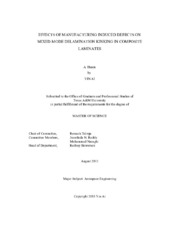| dc.description.abstract | With the superior mechanical performance, such as high strength and stiffness, fiber-reinforced polymer composites are widely used on main structures, like airfoil for aircraft or wind turbine. Manufacturing induced defects draw people’s attention for a long time and porosity content was characterized as critical factor that would destroy composite structure. In recent years, it has been noticed that rather than defects’ content, the shape, size and distribution are also important.
Some of the research focused on influence of defects on crack propagation along interface. Not much attention has been placed on effects for delamination crack kinking. In the current study, in order to explore how voids affect composites delamination kinking, a double cantilever beam (DCB) model with a delamination pre-crack was simulated under tensile loading condition. By a revised Virtual Crack Closure Technic, the strain energy release rates for crack extension in Mode I and Mode II were evaluated. A parametric research was performed with present of various shapes and sizes of voids in resin area. With applying the mixed-mode fracture criterion, the potential kinking angle was determined. In addition, the effects of circular voids in resin area after delamination kinked out was also examined.
Some of the following results have been found. The delamination in the current DCB model is Mode I dominated fracture process. The failure is governed by dilatational energy and it’s an elastic failure problem. Voids located in resin-reach area cause stress perturbation at crack tip and activate the delamination kinking at around 15-degree angle. The parametric study of voids with different geometry shows that elliptical voids compared with circular ones are more threatening to crack branching out. Size of voids is also a critical character that with identical distance from crack tip, larger voids accrete the crack kinking possibility. More importantly, distance between of crack tip and voids, regardless of their size and shape, is the most crucial factor for delamination kinking. | en |


